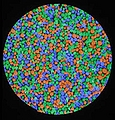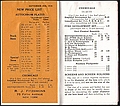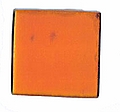 |
Register Subscribe Login |
| 1. |  | Unidentified photographer / artist 1900 (ca) 0. trichromatic stereo plate. Experimental plate using the process of MM Auguste and Louis Lumière, prior to the Autochrome Trichromatic stereo plate 9.5 x 18 cm Private collection - Darmet © Collection Darmet |
| 2. |  | Hugh Tifft n.d. Popular color auto-screens of the early 20th century - from the earliest 1907 Autochorme screen to the later screens of the Finlay and Paget plates. Photomicrographs Private collection of Hugh Tifft © Private collection High Tifft These auto-screens were photographed at 10x magnification. |
| 3. |  | Unidentified photographer / artist n.d. Microphotography of the Autochrome trichromatic selection mosaic, made of dyed potato starch grains (7000 grains / mm2) Photomicrograph Institut Lumičre (The Lumiere Institute) © Institut Lumiere |
| 4. |  | Unidentified photographer / artist n.d. Autochrome detail showing the starch grains dyed in orange, green and violet Autochrome Institut Lumičre (The Lumiere Institute) © Institut Lumiere |
| 5. |  | Unidentified photographer / artist 1920 (ca) The Lumiere factory in Lyons B&W plate 18 x 24 cm Institut Lumičre (The Lumiere Institute) © Institut Lumiere |
| 6. |  | Unidentified photographer / artist 1904 The 1904 announcement from Lumiere on the New Method of Color Photography: the Autochrome Private collection of Mark Jacobs © Collection Mark Jacobs |
| 7. |  | Unidentified photographer / artist 1904 The 1904 announcement from Lumiere on the New Method of Color Photography: the Autochrome Private collection of Mark Jacobs © Collection Mark Jacobs |
| 8. |  | n.d. Agenda Lumiere - advertisement Advert Private collection of Nadia Valla © Nadia Valla |
| 9. |  | Unidentified photographer / artist 1920 (ca) 13x18 Autochrome Lumiere box cover Box cover Institut Lumičre (The Lumiere Institute) © Institut Lumiere |
| 10. |  | 1911 "Color photography for all" - Booklet cover Book cover Private collection of Nadia Valla © Nadia Valla |
| 11. |  | n.d. Instruction manual for the autochrome plates Book cover Institut Lumičre (The Lumiere Institute) © Institut Lumiere |
| 12. |  | Unidentified photographer / artist n.d. Autochrome instruction manuals Private collection of Mark Jacobs © Collection Mark Jacobs Autochrome instruction manuals were frequently revised to reflect better working techniques as well as price increases and, less frequently, price decreases. |
| 13. |  | Unidentified photographer / artist n.d. Autochrome instruction manuals Private collection of Mark Jacobs © Collection Mark Jacobs Autochrome instruction manuals were frequently revised to reflect better working techniques as well as price increases and, less frequently, price decreases. |
| 14. |  | Unidentified photographer / artist n.d. Autochrome instruction manuals Private collection of Mark Jacobs © Collection Mark Jacobs Autochrome instruction manuals were frequently revised to reflect better working techniques as well as price increases and, less frequently, price decreases. |
| 15. |  | Unidentified photographer / artist n.d. From an Autochrome instruction manual. Various models of Diascopes. Private collection of Mark Jacobs © Collection Mark Jacobs |
| 16. |  | Unidentified photographer / artist n.d. From an Autochrome instruction manual. Various models of Diascopes. Private collection of Mark Jacobs © Collection Mark Jacobs |
| 17. |  | Unidentified photographer / artist n.d. Diascope Private collection of Nadia Valla © Nadia Valla |
| 18. |  | Unidentified photographer / artist n.d. Diascope Private collection of Nadia Valla © Nadia Valla |
| 19. |  | Unidentified photographer / artist n.d. German diascope box Private collection of Mark Jacobs © Collection Mark Jacobs |
| 20. |  | Unidentified photographer / artist n.d. German diascope Private collection of Mark Jacobs © Collection Mark Jacobs |
| 21. |  | Unidentified photographer / artist n.d. European diascope with girl Private collection of Mark Jacobs © Collection Mark Jacobs |
| 22. |  | Unidentified photographer / artist 1916, 20 September Price List for Autochrome Plates Booklet Private collection of Mark Jacobs © Collection Mark Jacobs |
| 23. |  | Unidentified photographer / artist n.d. Autochrome exposure meter (Front) Private collection of Mark Jacobs © Collection Mark Jacobs |
| 24. |  | Unidentified photographer / artist n.d. Autochrome exposure meter (Back) Private collection of Mark Jacobs © Collection Mark Jacobs |
| 25. |  | Unidentified photographer / artist 1911 Exposure times for the autochrome plate from booklet "Color photography for all" Private collection of Nadia Valla © Nadia Valla |
| 26. |  | Unidentified photographer / artist 1911 Diaphragm differences from booklet "Color photography for all" Private collection of Nadia Valla © Nadia Valla |
| 27. |  | Marcel Meys 1908 A girl at a table Autochrome Private collection of Mark Jacobs Collection Mark Jacobs "A girl at a table, lighted only by a petroleum lamp with a red shade, told a tale of endurance. The girl sat for twenty-two minutes. The result was excellent." from John C.Warburg's review "Colour Photography at the Grafton Galleries" (Nov. 6, 1908) |
| 28. |  | Unidentified photographer / artist n.d. Autochrome filter packaging Private collection of Mark Jacobs © Collection Mark Jacobs |
| 29. |  | Unidentified photographer / artist n.d. Autochrome filter Private collection of Mark Jacobs © Collection Mark Jacobs It was necessary to place a special yellow-orange filter over the picture taking lens. Autochromes were much more sensitive to blue than to daylight so the filter acted to balance the color. However, the filter increased exposure. |
| 30. |  | Unidentified photographer / artist 1908 Autochrome Whirler Instruction manual Private collection of Mark Jacobs © Collection Mark Jacobs Manufactured by Sanger-Shepherd & Co., Ltd., London, England These devices were invented soon after the autochrome came to the market and helped to eliminate the problem of "frilling". Frilling happened when the emulsion separated from the filter layer along the edges of the glass and was generally caused by poor methods of agitation. Though a consistent problem among many amateur photographers, it was also a short-lived problem among even among the most sophisticated autochromists including Edward Steichen. |
| 31. |  | Unidentified photographer / artist n.d. Verascope models Private collection of Mark Jacobs © Collection Mark Jacobs Cameras such as these, which were originally produced to make black and white stereo images, were adapted so as to be used to make stereo autochromes. |
| 32. |  | Unidentified photographer / artist 1924 The Taxiphote was an instrument designed for viewing and storing both black and white and autochrome stereoscopic transparencies. Catalogue page Private collection of Mark Jacobs © Collection Mark Jacobs Made by Jules Richard, Paris, France. Please note that the date given here of 1924 relates to the printed catalogue rather than to the invention of the Taxiphote that came out in around 1900 for black and white plates. One of the stereo autochrome formats (45mm x 107mm) was the same as that used by the Taxiphote and therefore it could be used for them. |